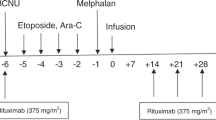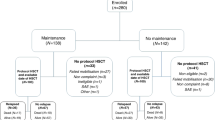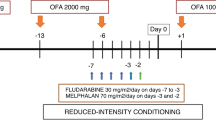Abstract
Reduced-intensity conditioning (RIC) hematopoietic SCT (HSCT) is a potentially curative therapeutic option for patients with advanced follicular lymphoma (FL), but disease relapse remains the most common cause of failure. Radioimmunoconjugates administered before RIC allo-HSCT may enhance cytoreduction and allow more time for GVL effect to develop without the associated toxicity of a myeloablative HSCT. We performed a retrospective study to describe the outcomes of patients with relapsed, refractory or transformed FL who received yttrium-90 (90Y)-ibritumomab tiuxetan followed by fludarabine and low-dose BU RIC allogeneic HSCT at the Dana-Farber Cancer Institute between 2006 and 2009, inclusively. Twelve patients were identified with a median age of 55 (40–66) years and a median number of lines of therapy of 5 (2–10). Two patients (17%) had transformed to a more aggressive histology and five (42%) had chemorefractory FL. Cumulative incidences of grade II–IV acute GVHD at 100 days were 17% (±11%) and chronic GVHD at 12 months were 63% (±19%). Two-year non-relapse mortality was 18% (±12%). Two-year OS and PFS were 83% (±11%) and 74% (±13%), respectively. This treatment is associated with favorable outcomes including acceptable rates of GVHD and relapse in advanced FL patients, and warrants prospective studies.
This is a preview of subscription content, access via your institution
Access options
Subscribe to this journal
Receive 12 print issues and online access
$259.00 per year
only $21.58 per issue
Buy this article
- Purchase on Springer Link
- Instant access to full article PDF
Prices may be subject to local taxes which are calculated during checkout




Similar content being viewed by others
References
Czuczman MS . Controversies in follicular lymphoma: ‘who, what, when, where, and why?’ (not necessarily in that order!). Hematol Am Soc Hematol Educ Program 2006; 1: 303–310.
Giné E, Montoto S, Bosch F, Arenillas L, Mercadal S, Villamor N et al. The Follicular Lymphoma International Prognostic Index (FLIPI) and the histological subtype are the most important factors to predict transformation in follicular lymphoma. Ann Oncol 2006; 17: 1539–1545.
Brown JR, Feng Y, Gribben JG, Neuberg D, Fisher DC, Mauch P et al. Long-term survival after autologous bone marrow transplantation for follicular lymphoma in first remission. Biol Blood Marrow Transplant 2007; 13: 1057–1065.
Sabloff M, Atkins HL, Bence-Bruckler I, Bredeson C, Fergusson D, Genest P et al. A 15-year analysis of early and late autologous hematopoietic stem cell transplant in relapsed, aggressive, transformed, and nontransformed follicular lymphoma. Biol Blood Marrow Transplant 2007; 13: 956–964.
Schouten HC, Qian W, Kvaloy S, Porcellini A, Hagberg H, Johnson HE et al. High-dose therapy improves progression-free survival and survival in relapsed follicular non-Hodgkin's lymphoma: results from the randomized European CUP trial. J Clin Oncol 2003; 21: 3918–3927.
Khouri IF, Saliba RM, Giralt SA, Lee MS, Okoroji GJ, Hagemeister FB et al. Nonablative allogeneic hematopoietic transplantation as adoptive immunotherapy for indolent lymphoma: low incidence of toxicity, acute graft-versus-host disease, and treatment-related mortality. Blood 2001; 98: 3595–3599.
Hari P, Carreras J, Zhang MJ, Gale RP, Bolwell BJ, Bredeson CN et al. Allogeneic transplants in follicular lymphoma: higher risk of disease progression after reduced-intensity compared to myeloablative conditioning. Biol Blood Marrow Transplant 2008; 14: 236–245.
Peters MV, Busch RS, Brown TC, Reid J . The place of radiotherapy in the control on non-Hodgkin's lymphomata. Br J Cancer 1975; 2: 386–401.
Gordon LI, Molina A, Witzig T, Emmanouilides C, Raubtischek A, Darif M et al. Durable responses after ibritumomab tiuxetan radioimmunotherapy for CD20+ B-cell lymphoma: long-term follow-up of a phase 1/2 study. Blood 2004; 103: 4429–4431.
Davis TA, Kaminski MS, Leonard JP, Hsu FJ, Wilkinson M, Zelenetz A et al. The radioisotope contributes significantly to the activity of radioimmunotherapy. Clin Cancer Res 2004; 10: 7792–7798.
Wiseman GA, Gordon LI, Multani PS, Witzig TE, Spies S, Bartlett NL et al. Ibritumomab tiuxetan radioimmunotherapy for patients with relapsed or refractory non-Hodgkin lymphoma and mild thrombocytopenia: a phase II multicenter trial. Blood 2002; 99: 4336–4342.
Witzig TE, Flinn IW, Gordon LI, Emmanouilides C, Czuczman MS, Saleh MN et al. Treatment with ibritumomab tiuxetan radioimmunotherapy in patients with rituximab-refractory follicular non-Hodgkin's lymphoma. J Clin Oncol 2002; 20: 3262–3269.
Witzig TE, Molina A, Gordon LI, Emmanouilides C, Schilder RJ, Flinn IW et al. Long-term responses in patients with recurring or refractory B-cell non-Hodgkin lymphoma treated with yttrium 90 ibritumomab tiuxetan. Cancer 2007; 109: 1804–1810.
Emmanouilides C, Witzig TE, Wiseman GA, Gordon LI, Wang H, Schilder R et al. Safety and efficacy of yttrium-90 ibritumomab tiuxetan in older patients with non-Hodgkin's lymphoma. Cancer Biother Radiopharm 2007; 22: 684–691.
Pagel JM, Gooley TA, Rajendran J, Fisher DR, Wilson WA, Sandmaier BM et al. Allogeneic hematopoietic-cell transplantation after conditioning with 131I-anti-CD45 antibody plus fludarabine and low-dose total body irradiation for elderly patients with advanced acute myeloid leukemia or high-risk myelodysplastic syndrome. Blood 2009; 114: 5444–5453.
Fietz T, Uharek L, Gentilini C, Muessig A, Rieger K, Marinets O et al. Allogeneic hematopoietic cell transplantation following conditioning with 90Y-ibritumomab-tiuxetan. Leuk Lymphoma 2006; 47: 59–63.
Shimoni A, Zwas ST, Oksman Y, Hardan I, Shem-Tov N, Rand A et al. Ibritumomab tiuxetan (Zevalin) combined with reduced-intensity conditioning and allogeneic stem-cell transplantation (SCT) in patients with chemorefractory non-Hodgkin's lymphoma. Bone Marrow Transplant 2008; 41: 355–361.
Armand P, Kim HT, Ho VT, Cutler CS, Koreth J, Antin JH et al. Allogeneic transplantation with reduced-intensity conditioning for Hodgkin and non-Hodgkin lymphoma: importance of histology for outcome. Biol Blood Marrow Transplant 2008; 14: 418–425.
Alyea EP, Li S, Kim HT, Cutler C, Ho V, Soiffer RJ et al. Sirolimus, tacrolimus, and low-dose methotrexate as graft-versus-host disease prophylaxis in related and unrelated donor reduced-intensity conditioning allogeneic peripheral blood stem cell transplantation. Biol Blood Marrow Transplant. 2008; 14: 920–926.
Ho VT, Aldridge J, Kim HT, Cutler C, Koreth J, Armand P et al. Comparison of tacrolimus and sirolimus (Tac/Sir) versus tacrolimus, sirolimus, and mini-methotrexate (Tac/Sir/MTX) as acute graft-versus-host disease prophylaxis after reduced-intensity conditioning allogeneic peripheral blood stem cell transplantation. Biol Blood Marrow Transplant 2009; 15: 844–850.
Przepiorka D, Weisdorf D, Martin P, Klingemann HG, Beatty P, Hows J et al. 1994 Consensus conference on acute GVHD grading. Bone Marrow Transplant 1995; 15: 825–828.
Morschhauser F, Radford J, Van Hoof A, Vitolo U, Soubeyran P, Tilly H et al. Phase III trial of consolidation therapy with yttrium-90-ibritumomab tiuxetan compared with no additional therapy after first remission in advanced follicular lymphoma. J Clin Oncol 2008; 26: 5156–5164.
Fisher RI, Kaminski MS, Wahl RL, Knox SJ, Zelenetz AD, Vose JM et al. Tositumomab and iodine-131 tositumomab produces durable complete remissions in a subset of heavily pretreated patients with low-grade and transformed non-Hodgkin's lymphomas. J Clin Oncol 2005; 23: 7565–7573.
Shimoni A, Zwas ST, Oksman Y, Hardan I, Shem-Tov N, Yerushalmi R et al. Yttrium-90-ibritumomab tiuxetan (Zevalin) combined with high-dose BEAM chemotherapy and autologous stem cell transplantation for chemo-refractory aggressive non-Hodgkin's lymphoma. Exp Hematol 2007; 35: 534–540.
Vose JM, Bierman PJ, Enke C, Hankins J, Bociek G, Lynch JC et al. Phase I trial of iodine-131 tositumomab with high-dose chemotherapy and autologous stem-cell transplantation for relapsed non-Hodgkin's lymphoma. J Clin Oncol 2005; 23: 461–467.
Bethge WA, Lange T, Meisner C, von Harsdorf S, Bornhaeuser M, Federmann B et al. Radioimmunotherapy with yttrium-90-ibritumomab tiuxetan as part of a reduced intensity conditioning regimen for allogeneic hematopoietic cell transplantation in patients with advanced non-Hodgkin lymphoma: results of a phase II study. Blood 2010; 116: 1795–1802.
Rezvani AR, Storer B, Maris M, Sorror ML, Agura E, Maziarz RT et al. Nonmyeloablative allogeneic hematopoietic cell transplantation in relapsed, refractory, and transformed indolent non-Hodgkin′s lymphoma. J Clin Oncol 2008; 26: 211–217.
Ratanatharathorn V, Logan B, Wang D, Horowitz M, Uberti JP, Ringden O et al. Prior rituximab correlates with less acute graft-versus-host disease and better survival in B-cell lymphoma patients who received allogeneic peripheral blood stem cell transplantation. Br J Haematol 2009; 145: 816–824.
Armand P, Gannamaneni S, Kim HT, Cutler CS, Ho VT, Koreth J et al. Improved survival in lymphoma patients receiving sirolimus for graft-versus-host disease prophylaxis after allogeneic hematopoietic stem-cell transplantation with reduced-intensity conditioning. J Clin Oncol 2008; 26: 5767–5774.
Robinson SP, Goldstone AH, Mackinnon S, Carella A, Russell N, de Elvira CR et al. Chemoresistant or aggressive lymphoma predicts for a poor outcome following reduced intensity allogeneic progenitor cell transplantation: an analysis from the Lymphoma Working Party of the European Group for Blood and Bone Marrow Transplantation. Blood 2002; 100: 4310–4316.
Acknowledgements
This work was supported in part by NIH Grant CA142106 and the Jock and Bunny Adams Research and Teaching Endowment. ASF is supported in part by NIH/NCI P01 Grant CA92625.
Author information
Authors and Affiliations
Corresponding author
Ethics declarations
Competing interests
The authors declare no conflict of interest.
Rights and permissions
About this article
Cite this article
Abou-Nassar, K., Stevenson, K., Antin, J. et al. 90Y-ibritumomab tiuxetan followed by reduced-intensity conditioning and allo-SCT in patients with advanced follicular lymphoma. Bone Marrow Transplant 46, 1503–1509 (2011). https://doi.org/10.1038/bmt.2010.339
Received:
Revised:
Accepted:
Published:
Issue Date:
DOI: https://doi.org/10.1038/bmt.2010.339
Keywords
This article is cited by
-
The role of stem cell transplantation in the management of relapsed follicular lymphoma in the era of targeted therapies
Bone Marrow Transplantation (2019)
-
Allogeneic Stem Cell Transplantation for Non-Hodgkin Lymphoma
Current Hematologic Malignancy Reports (2016)
-
CD20-targeting in B-cell malignancies: novel prospects for antibodies and combination therapies
Investigational New Drugs (2016)
-
Long-term outcome after autologous or allogeneic stem cell transplantation in patients with recurrent follicular lymphoma
Bone Marrow Transplantation (2012)



